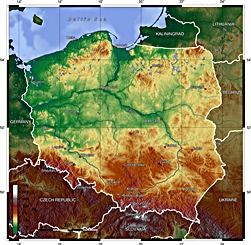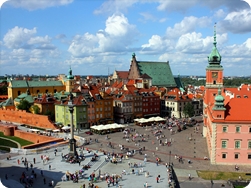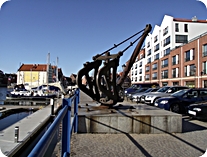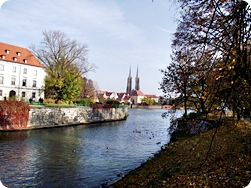
Geography of Poland
 Location:
The geography of Poland locates the country in Central Europe on the North European Plain, east of Germany, north of Czech Republic and Slovakia, West of Ukraine and Belarus, south of Russia and Lithuania.
Location:
The geography of Poland locates the country in Central Europe on the North European Plain, east of Germany, north of Czech Republic and Slovakia, West of Ukraine and Belarus, south of Russia and Lithuania.
Within the North European Plain, terrain variations generally run in bands from east to west. The Baltic coast is lacking in natural harbors except for the Gdańsk, Gdynia area and Szczecin in the far north west of Poland.
The geography of Poland is split into the north eastern region known as the Polish Lake District which is densely wooded, sparsely populated and has little in the way of agricultural and industrial resources. To the south and west of the Polish lake district there is a vast region of plains extending to the Sudetes on the Czech and Slovak national borders, to the south west and to the Carpathian Mountains on the Czech, Slovak, and Ukrainian national borders in the south east of the country.
Rivers within Poland
Poland has 29 major rivers with a total length of about 19,000 km of which 4,800 km are open to navigation. The largest river of Poland is the Vistula (Wisla) which has it's origin at Barania Góra in the Beskidy Mountains and runs the full length of Poland exiting into the Baltic at Gdańsk Bay.
Climate of Poland
The geography of Poland creates a climate that is temperate with relatively cold winters and warm summers and is greatly influenced by oceanic air currents from the west, cold polar air from Scandinavia and Russia, as well as warmer, sub-tropical air from the south.
Geographical Statistics of Poland
Geographic coordinates: 52 00 N, 20 00 E
Total Area: 312,677 sq km
Landmass: 304,465 sq km
Water coverage: 8,220 sq km
Land Boundaries: 2,788 km
Border Countries and Length: Belarus 407 km, Czech Republic 658 km, Germany 456 km, Lithuania 91 km, Russia (Kaliningrad Oblast) 206 km, Slovakia 444 km, Ukraine 526 km
Coastline: 491 km to the north only, on the Baltic Sea.
Maritime Claims: territorial sea: 12 nm
Climate Type: temperate with cold, cloudy, moderately severe winters with frequent precipitation; mild summers with frequent showers and thunderstorms.
Terrain: Mostly flat plains; mountains along southern border.
Elevation Extremes: Lowest point: near Raczki Elblaskie -2 m, highest point: Rysy 2,499 m (Tatra Mountains)
Natural Resources: Coal, sulphur, copper, natural gas, silver, lead, salt, amber, arable land.
Land use as at 2001: Arable land: 45.91%, permanent crops: 1.12%, other: 52.97%
Irrigated land: 1,000 sq km (1998 estimated).
Natural Hazards: Mainly flooding as a result of swollen rivers.
Geography of Poland Environment Issues:
The situation is continuing to improve since 1989 due to the decline in Poland's heavy industry and the greater interest of environmental concern by post-Communist governments; air pollution nonetheless remains a serious problem because of sulfur dioxide emissions from the many coal-fired power plants, resulting in acid rain causing forest damage; water pollution from industrial and municipal sources is also a major problem, as is disposal of hazardous wastes; pollution levels should continue to decrease as industrial establishments bring their facilities up to the European Union code, but this will mean substantial costs to businesses and the Government.
Environment and International Agreements: Poland is party to: Air Pollution, Antarctic-Environmental Protocol, Antarctic-Marine Living Resources, Antarctic Seals, Antarctic Treaty, Biodiversity, Climate Change, Climate Change-Kyoto Protocol, Desertification, Endangered Species, Environmental Modification, Hazardous Wastes, Kyoto Protocol, Law of the Sea, Marine Dumping, Ozone Layer Protection, Ship Pollution, Wetlands. – signed, but not yet ratified: Air Pollution-Nitrogen Oxides, Air Pollution-Persistent Organic Pollutants, Air Pollution-Sulfur 94.
Other: The geography of Poland has helped historically to create an area of conflict, due to it's flat terrain and the lack of natural barriers on the North European Plain.
Geography of Poland - David's Travel Guides




